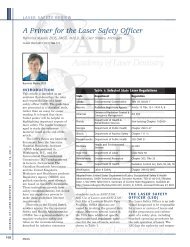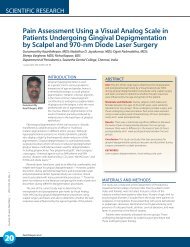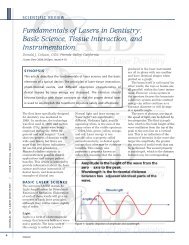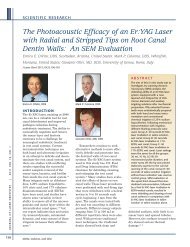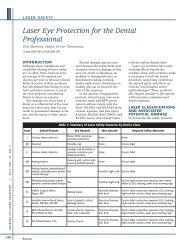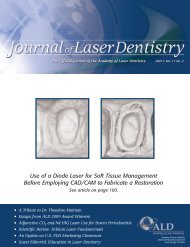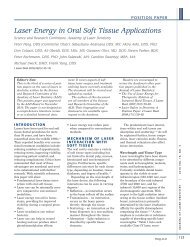You also want an ePaper? Increase the reach of your titles
YUMPU automatically turns print PDFs into web optimized ePapers that Google loves.
Signs <strong>of</strong> Change<br />
Raminta Mastis, DDS, FAGD, MALD, St. Clair Shores, Michigan<br />
J <strong>Laser</strong> Dent 2011;19(3):301-302<br />
Raminta Mastis, DDS, <strong>Laser</strong> Safety<br />
Committee Chairwoman<br />
The proper display <strong>of</strong> signs is an<br />
essential element in implementing<br />
a successful laser safety program in<br />
the workplace. Since many lasers,<br />
when active, are invisible, they<br />
pose a potentially hazardous environment.<br />
Even small amounts <strong>of</strong><br />
laser light can cause permanent<br />
eye injuries or skin burns. Signs<br />
serve an important function in<br />
identifying hazards, and in giving<br />
directions for appropriate precautions,<br />
warnings, and protection. The<br />
purpose <strong>of</strong> this article is to provide<br />
guidelines specified in ANSI<br />
Z136.1-2007 American National<br />
Standard for Safe Use <strong>of</strong> <strong>Laser</strong>s for<br />
signs in order to properly warn<br />
people <strong>of</strong> the potential laser-related<br />
health hazards in your workplace.<br />
In a dental laser treatment<br />
setting there are two main types <strong>of</strong><br />
signs: equipment labels and area<br />
warning signs. Equipment labeling<br />
is primarily the responsibility <strong>of</strong><br />
the manufacturer. Dental lasers<br />
sold in the USA must achieve U.S.<br />
Food and Drug Administration<br />
(FDA) marketing clearance, which<br />
includes the permanent affixing <strong>of</strong><br />
various warning and information<br />
labels on the laser equipment itself.<br />
The operator and <strong>Laser</strong> Safety<br />
Officer (LSO) should be aware <strong>of</strong><br />
these and understand their meanings.<br />
These labels identify<br />
protective features and potential<br />
hazards if the laser is tampered<br />
with. Equipment labels also iden-<br />
tify the class <strong>of</strong> laser and degree <strong>of</strong><br />
hazards. The LSO should inspect<br />
these labels to assure that they are<br />
intact, legible, securely affixed, and<br />
document such inspections in a<br />
logbook or an annual checklist. If a<br />
label becomes illegible or comes <strong>of</strong>f,<br />
the manufacturer should be<br />
contacted for a replacement label.<br />
Since area warning signs are<br />
used to indicate a change <strong>of</strong> environment,<br />
they demand more daily<br />
attention in order to serve the<br />
purpose <strong>of</strong> safety. Area warning<br />
signs are the responsibility <strong>of</strong> the<br />
LSO and/or the delegated team<br />
members. The appropriate uses for<br />
these signs <strong>of</strong> change are addressed<br />
in ANSI 136.1-2007, Section 4.7.<br />
Area warning signs are used to<br />
control areas where lasers are being<br />
used. In general, signs for Class 2<br />
and 2M lasers will have the signal<br />
word “Caution,” and will typically be<br />
yellow. Signs for Class 3R, 3B, and 4<br />
lasers will use the signal word<br />
“Danger,” and will be in red. Most<br />
manufacturers provide a preprinted<br />
warning sign with the pertinent<br />
information (type <strong>of</strong> laser, emitted<br />
wavelength, pulse duration,<br />
maximum output, laser class, and<br />
special precautionary instructions<br />
and protective actions) for use by the<br />
operator. Additional signs can be<br />
requested from the manufacturer,<br />
photocopied, or downloaded from the<br />
Internet (paper copy, which you may<br />
want to laminate), or purchased<br />
from various companies or Web sites<br />
that <strong>of</strong>fer laser safety signs (usually<br />
plastic), such as <strong>Laser</strong> Institute <strong>of</strong><br />
America (www.lia.org).<br />
The regulations require that<br />
these area warning signs be<br />
conspicuously displayed before the<br />
entry into the controlled area,<br />
which is determined by the specific<br />
laser’s Nominal Hazard Zone<br />
(NHZ). The regulations also require<br />
L A S E R S A F E T Y<br />
that these signs be covered or<br />
removed when the laser is effectively<br />
taken out <strong>of</strong> operation (which<br />
should be interpreted as laser shutdown<br />
and not just placed in<br />
standby mode). Most dental lasers<br />
are designed to be portable,<br />
meaning that they can be used in<br />
several treatment areas throughout<br />
the day. If the laser is moved to<br />
different locations (i.e., multiple<br />
treatment areas), the signs should<br />
be changed to clearly indicate<br />
where and when a laser is in use in<br />
order to appropriately warn at all<br />
entries into the NHZ.<br />
Accidents happen, <strong>of</strong>ten when<br />
they are least expected. A trained<br />
and experienced skydiver is more<br />
likely to sprain his ankle by tripping<br />
on a rug or a stair in his own<br />
home than from jumping from a<br />
perfectly good airplane over a mile<br />
<strong>of</strong>f the ground, while being<br />
suspended by a strip <strong>of</strong> fabric (parachute).<br />
The same analogy can be<br />
applied in the dental <strong>of</strong>fice. Be<br />
prepared for the unexpected. Be<br />
alert to your environment. Be aware<br />
<strong>of</strong> the stray traffic near the NHZ.<br />
Traffic control within hazard<br />
zones should be managed with<br />
clear and standard operating procedures.<br />
It is the responsibility <strong>of</strong> the<br />
staff to manage stray traffic (such<br />
as a concerned parent “peeking<br />
in”). The staff should also be<br />
trained to recognize that interruptions<br />
for “just a quick question” are<br />
inappropriate during laser procedures.<br />
It is recommended that<br />
other forms <strong>of</strong> inter-<strong>of</strong>fice communications,<br />
such as text-messaging<br />
systems, be included in the standard<br />
operating procedures.<br />
In addition to the appropriate<br />
display <strong>of</strong> Caution and Danger<br />
signs, there is a third type <strong>of</strong> sign<br />
defined by ANSI to identify a<br />
Temporary <strong>Laser</strong> Controlled Area.<br />
Mastis<br />
J O U R N A L O F L A S E R D E N T I S T R Y | 2 011 V O L . 19 , N O . 3<br />
301





